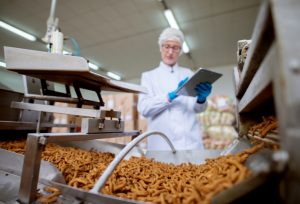 Following an unexpected year, many of 2020’s food manufacturing trends have carried over into 2021 and continue to set the stage for the manufacturing environment globally. For the future of food manufacturing, one of the biggest markers of a post-pandemic world remains: supply & labor shortage.
Following an unexpected year, many of 2020’s food manufacturing trends have carried over into 2021 and continue to set the stage for the manufacturing environment globally. For the future of food manufacturing, one of the biggest markers of a post-pandemic world remains: supply & labor shortage.
In 2020, when the shutdown commenced, consumer spending followed suit. With restaurants and other retail outlets closed, demand for ingredients and goods quickly left as well, leaving farmers and suppliers with excess inventory. You may recall videos of farmers pouring milk on the ground simply because they could no longer sell it. This massive reduction in demand became a death blow for many suppliers around the world, forcing many to reduce the size of their operations or close doors altogether. The problem is: this recession didn’t last forever and as we move further into 2021, we’re back to pre-COVID levels of demand for goods and for food. With many legacy suppliers now a year behind in production and unable to provide goods at the volumes previously projected, we are diving further into a supply shortage and the resulting inflation. The effects of this are being felt on every portion of the industry; farming, shipping, oil, manufacturing, retail… and the storm is not yet easing. Following close behind is the self-inflicted wound of stimulus money on labor.
With a low participation in the labor market through 2020, a continued stimulus offering, and an upwards trend in U.S. spending as COVID restrictions begin to lift, demand is quickly outstripping supply. The resulting inflation can be felt within commodity pricing all the way through retail prices on food. Everyday goods are quickly becoming far more expensive. Government stimulus created a financial incentive for workers to stay home, creating a self-inflicted ripple effect that will likely burden the industry until these programs cease. The benefit of those subsidies is being eroded rapidly by the subsequent cost of living for all Americans with the spike in inflation and the resulting reduction in the value of the dollar. The sooner the world begins working at pre-COVID rates, the quicker the nation will begin to recover.
Trends in Food Production That Drive The Industry
Safety continues to earn a strong place on consumer radars. The food manufacturing industry is keeping in line with technological advancements and consumer demands.
As the standards in consumer safety rise, manufacturers must continue to follow all new guidelines and practices amidst continuing to innovate. Prioritizing buyer preferences, processing costs and safe techniques are all important aspects of delivering a satisfactory product to the market and homes of consumers.
When it comes to food manufacturing industry trends for 2021, here’s what to expect:
- Company Transparency: In the past, people have made purchasing decisions based on brand loyalty and attractive packaging. However, over the years, recalls and food warnings have plagued the industry — and big brands were no exception. Shoppers expect a certain level of transparency from companies to ensure they’re getting the safest, cleanest items for their families.
- Plant-Based Formulas: Products derived from plants have expanded in the mainstream market by 36% in the last year; they can be found in nearly every food category. Plant-based products rate high on the demand list because of health, diet variety, sustainability and taste. These vegetarian options give individuals and families healthier alternatives to everyday favorites.
- Convenient Meal Solutions: Many people have adapted to a work-from-home lifestyle, with limited access to restaurants. Instead, consumers have focused on cooking habits, aiming to recreate exotic flavors at home. They seek convenience, richer experiences and accessibility when it comes to their food, looking for options that replicate their favorite flavors and restaurants.
- Nutritional Priorities: Three in five consumers are making it a point to buy products that support their immune health. As technology advances, so does the public’s demand for foods that taste great but also aid in their body’s natural defense system. Nutritional ingredients that used to be found only in the supplement aisle are now often available in many everyday products — and consumers are loving it.
- Sustainability: About 65% of consumers monitor their everyday actions in hopes of positively affecting the environment, starting with what’s in the fridge and pantry. Upcycled items — such as those that can be used as renewable food sources and those that cut waste — are gaining traction with people who want to reduce their carbon footprints. Many shoppers are also willing to spend more for eco-friendly packaging and processes.
- Clean Labels: Labels tell all, from company policies to business ethics. Previously overlooked, labels are now an integral part of a person’s shopping decisions: People now search for what is in the food, how it is made and by whom. The accessibility of this information often drives consumers to and away from certain products, causing manufacturers to create quality products with easy-to-read labels.
Since COVID-19, 85% of consumers have made changes to their food consumption. When it comes to the success of food manufacturers, it’s important to analyze why certain trends occur and how future predictions can influence the industry.
PacMoore offers food manufacturing services that reflect the latest trends, while maintaining our world-class manufacturing standards, integrity and excellence. We offer a wide range of services, including turnkey processing.
Contact PacMoore today to learn more about what we do, and get started with your specialized product and packaging manufacturing.